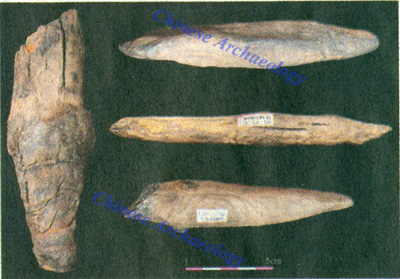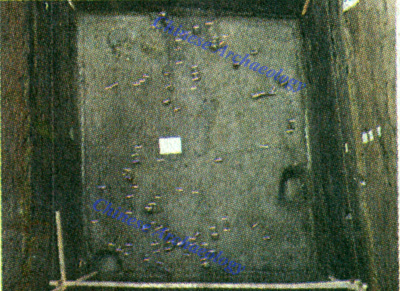Gantangjing Paleolithic site in Jiangchuan, Yunnan Province
From:Chinese Archaeology NetWriter:Date:2016-05-17
From October 2014 to February 2015, initiative excavation of Gantangjing Paleolithic site in Jiangchuan, Yunnan Province has been carried out by Yunnan Provincial Institute of Cultural Relics and Archaeology. The excavated area covers 50 square meters. During this season of field work, digital archaeological theory and method are applied, which bring breakthrough achievements.
Overlook of the Gantangjing Paleolithic site
Cultural Relics and remains
A fire-using remain was found in the site. Besides, 25153 stone artifacts are unearthed, including 658 stone cores, 564 flakes, 102 primary chopping debris and 192 tools. There are 28 bone artifacts and over 10 wooden artifacts. Moreover, rich fauna and flora fossils are excavated, too.

The fire-using remain found in excavation unit
The fire-using remain found in the upper cultural deposits was a campfire. Fire-woods were put toward the center, which were heavily carbonized near the center part. Besides, there were carbon deposits accumulated in the center. No obvious ash deposits and burnt earth are uncovered. Therefore, according to the above, this should be a temporary fire-using remain. The discovery of well-preserved open area fire-using remains in Gantangjing site is quite rare. As a significant find in Paleolithic Archaeology in China, it is of great values in terms of interpreting prehistoric human behaviors and as well lifestyles.

Stone artefacts unearthed from the site
The mainstreams of the stone artifacts in the site are small ones. The main raw materials are silicolite and quartz. Stone artifacts include tools, stone cores, flakes, debris and broken flakes and so on. The tools contain scrapers, notched-scrapers, points, graver and etc. Among them, scrapers take the largest part. The discovery of small flake industry in southern China probably will change previous understandings of two cultural systems of southern China and northern China.
According to the characteristics of the stone artifacts, there are two kinds of pounding techniques. One is the traditional one, “typical pounding technique”, hitting stone cores along their long axis, while the other is hitting along the short axis. Both of the two techniques are interacted and blended in production process, forming the unique pounding technique cultural system of Gantangjing site.

Wood artefacts recovered from the site
The bone artifacts, horn artifacts and wood artifacts discovered in the site are usually made in the shapes of points and shovels, enriching the cultural implications of the site which is mainly about stone culture. This obviously implies the diversity of ancient human’s production methods and lifestyles. Due to special taphonomic environment of Gantangjing site, well-preserved wooden artifacts are unearthed, which not only fills the gap of relevant research in China, but also provides useful references for research on “Bamboo and Wood Cultures” in Southeast Asia.
Well-preserved and rich kinds of fauna and flora fossils are found. According to the preliminary research, there are large mammal animals including cats, macaques, stegodons, rhinoceros, pigs, deer, muntjac deer and oxen and so on and as well plenty of small mammal animals, birds, reptiles and invertebrates fossils. They provide precious materials for the research on ancient human living environment, hunting and gathering behaviors as well as the resources and kinds of food used by ancient people.

Specimen exposed on the third horizontal layer of the 17th level in T1
Date of the site
Considering the fauna fossils found in the site, the date of Gantangjing site could belong to early Pleistocene. Besides, the primitive stone industry in the site conforms to the characteristics of this period, too.
Significance
There are several cultural stratums with clear layers being found in Gantangjing site. The cultural relics as well as fauna and flora remains are quite rich. The cultural remains are proto and unique with great taphonomic and preserved conditions. They are of special values and meaning for research in terms of human living pattern, origins and development of human beings and ancient environment background.
As another very important open-area site of early Paleolithic after the discovery of Yuanmouren site in Yunnan Province, the excavation achieved many important archaeological finds. All aspects of the data of the site have been collected completely. Without doubt, the discovery, excavation and as well research of this site provide new evidences for the theory of locally origins of ancient human beings in East Asia. (Translator: Ma Huanhuan)

